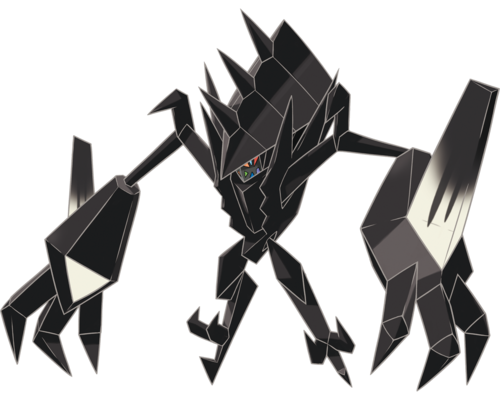
Today we’re going to look at… probably the closest thing that Ultra Sun and Moon have to an antagonist: the mysterious, sinister light-devouring Pokémon, Necrozma. With an all-black colour scheme, a name that incorporates the ancient Greek word for corpse, a mysterious extraterrestrial origin, and the ability to blast everything in sight with frikkin’ laser beams, this is clearly a Pokémon to run away from very fast. But what actually is it? Let’s discuss.
The Pokédex names Necrozma “the Prism Pokémon,” and its highly angular design, all sharp angles and flat surfaces, seems meant to recall a simple glass prism, just like you might use for playing with light and making little rainbows on a piece of paper or a wall. Most of Necrozma’s body is black, but if you look closely at its face you can see glints of many different colours, as if to evoke the splitting of light into a rainbow by a prism (concept art indicates that the “face” is actually one edge of its triangular “brain prism”). As a living prism, Necrozma has the power to manipulate light, and fights by focusing light into devastating laser beams, like a glass or crystal lens (as we see in its two signature moves, Photon Geyser and Prismatic Laser). We first encountered it in its normal state (at the time, the only form it had) on the original Sun and Moon, and are informed by the Pokédex that it draws energy from light. Again like a prism, it doesn’t produce its own light – its body is dark, and it has to absorb light from its surroundings and its opponents. When Necrozma is seen from behind, for instance when you use it in a battle, the back of its head forms a diamond shape that is suspiciously reminiscent of a Z-crystal – we later learn that Necrozma has some kind of connection with the crystals and the energy that empowers them; more on that later. Necrozma is described as a vicious, dangerous and unpredictable Pokémon that feeds on light, seems to be in constant pain, and eventually darkens and becomes immobile if it is unable to feed.
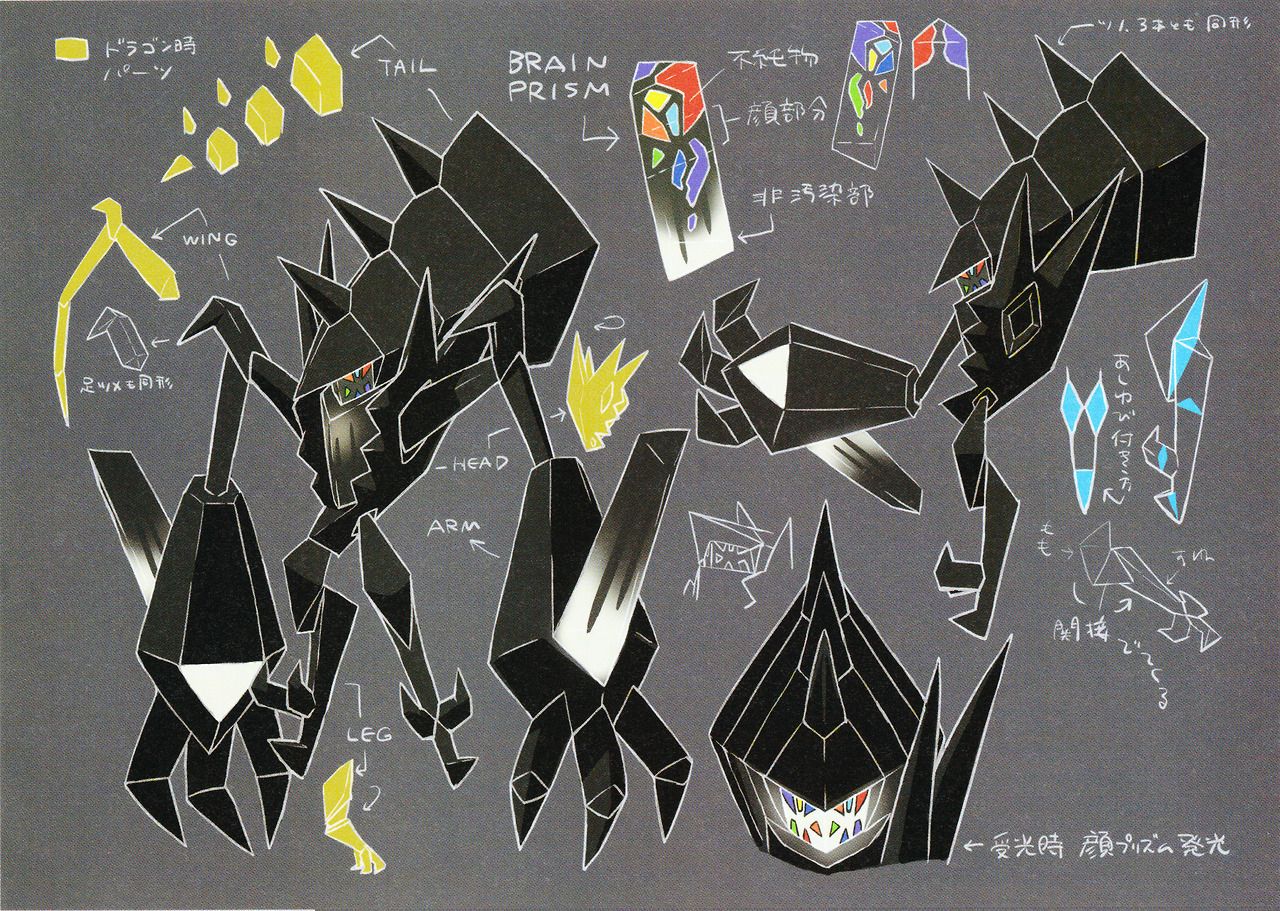
We are first alerted to Necrozma’s presence in Alola in the aftermath of the Ultra Beast-hunting subplot by Looker, who saw a strange black shape flying through the sky, “shining somehow… like it was refracting light.” Looker was afraid it might be another Ultra Beast, but is reassured by his partner Anabel that neither their superiors in Interpol nor their allies in the Aether Foundation have detected any new Ultra Beasts. That’s the last we ever hear of that, even after actually encountering and catching Necrozma in the remote “Farthest Hollow” of Ten Carat Hill. The Pokédex on Sun version calls it “reminiscent of an Ultra Beast” but isn’t willing to stick its neck out and explicitly contradict the Aether Foundation on this one. Ultimately the games seem to come down on the side of it not being an Ultra Beast, because it reacts to Pokéballs like an ordinary Pokémon (Ultra Beasts are almost impossible to catch without Beast Balls, which are in turn basically useless against terrestrial Pokémon). In the anime, by contrast, Lusamine and her staff (who coordinate the kids’ efforts to combat the Ultra Beast incursions) decide that Necrozma is indeed an Ultra Beast, giving it the designation UB Black. It definitely seems to be an otherworldly creature of some sort or other. The anime and Ultra Smoon are pretty consistent in saying that it came to Alola via an Ultra Wormhole, and that’s… more or less the only clear definition we’ve ever been offered for what an Ultra Beast actually is. Sun version claims that Necrozma has been in Alola since ancient times (presumably it was woken up by the recent Ultra Wormhole activity or the presence of Solgaleo or Lunala) and “is thought to have come from another world,” but the game doesn’t specify how. According to the Aether Foundation, we need Beast Balls to deal with Ultra Beasts because their biology is so alien that ordinary Pokéballs have trouble recognising them as Pokémon – of course, Necrozma is a being of glass that feeds on pure light, so I think there’s some argument it qualifies, but ordinary Pokéballs seem to be able to figure this one out. I’m therefore going to go on the record as treating Necrozma’s status as an Ultra Beast as “well obviously it is, except for the fact that it’s not.”
Confused yet? Don’t worry; it gets worse.

Like Kyurem before it, Necrozma has the ability to take control of one of the other legendary Pokémon of its trio, Solgaleo or Lunala, and fuse with it, creating two new forms entitled “Dusk Mane” (for the fusion with Solgaleo) and “Dawn Wings” (for the fusion with Lunala. In the wild, and in the course of the story of Ultra Smoon, Necrozma does this on its own; the player can control or reverse the process using a pair of special devices created for the Ultra Recon Squad by Colress, the scientist character who debuted in Black and White 2 (whose name, derived from “colourless,” takes on a new symbolic significance in dealing with a prism Pokémon). These forms look like Solgaleo and Lunala, glowing in the pale yellow and blue colours of their Radiant Sun and Full Moon phases, with pieces of Necrozma’s glassy black body rearranged around them into sinister dark armour. Necrozma also takes on Solgaleo or Lunala’s type, and learns the appropriate signature move, Sunsteel Strike or Moongeist Beam; it can even use the special Z-crystals associated with those moves. Necrozma is the one fully in control though, as the Pokédex explains, emphasising its viciousness and unpredictability. In both forms, we also see a triangle on the Pokémon’s forehead that shimmers with rainbow colours (the same “brain prism” viewed from a new angle). If Solgaleo represents midday and Lunala represents midnight, the names “Dusk Mane” and “Dawn Wings” place Necrozma’s two forms at the intermediate points, the boundaries between day and night, when neither the sun nor the moon are at their brightest. In Japanese, the two have similar names, tasogare no tategami (“Mane of Twilight”) and akatsuki no tsubasa (“Wings of Dawn”). However, official materials sometimes also give them the alternate (and in my opinion much better) names nisshoku and gesshoku – “Solar Eclipse” and “Lunar Eclipse” – because Necrozma darkens Solgaleo and Lunala, blocking out their light. The Japanese words for eclipses literally mean “sun-eating” and “moon-eating” (more on this theme in my previous article on the sun and moon Pokémon themselves), here referencing the way Necrozma “devours” light.
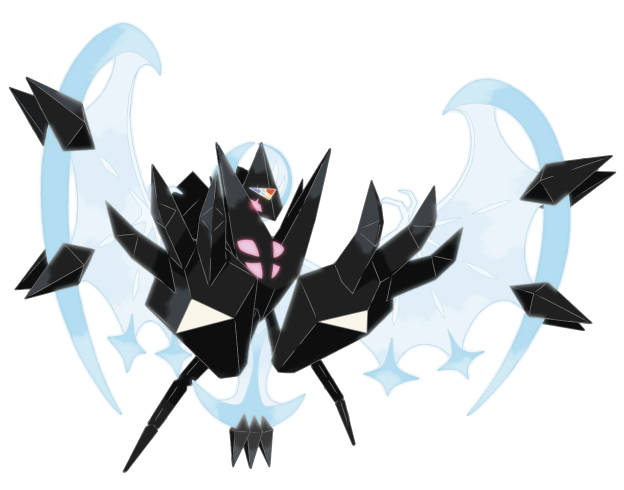
In their descriptions from the Ultra Smoon website, both Dawn Wings and Dusk Mane Necrozma are said to use “black light” to propel themselves through space. “Black light” in the real world is a common name for artificial sources of ultraviolet light, which is invisible to the human eye. I half suspect this is just a coincidence, and these descriptions are supposed to make us imagine a sort of black-coloured energy or a beam of darkness or something… but the generation VII games are pretty consistently obsessed with putting the prefix “Ultra” on things, so something that could conceivably be a reference to ultraviolet might be worth a second look. Ultraviolet light can be damaging, even destructive, to living cells – as anyone who has ever suffered sunburn or snow-blindness will attest. Necrozma, in its Dusk and Dawn forms, likewise takes the light of the sun (or moon) and alters its properties to turn it into a destructive force. But ultraviolet light in low doses can also be beneficial to human health; we need it to stimulate our skins to produce vitamin D, which is naturally present in only a handful of foods. Ultraviolet is also known for the way it causes a wide variety of other materials to visibly fluoresce, often in vivid colours (this is why black lights are often used for finding organic residue). Both of these things, for me, bring to mind the way Necrozma is said to have once shared its light with the universe, altering nature and all living things in miraculous ways. Again… hard to say if any of this is a deliberate reference, but the importance of the “Ultra” prefix, especially in the name of Necrozma’s final form, makes the idea attractive to me.

Either the Dusk Mane or the Dawn Wings form can become even greater through a process the game calls “Ultra Burst” (it’s… it’s basically Mega Evolution but just for Necrozma). Necrozma has to be holding its unique Z-crystal, the Ultranecrozium-Z, and can transform on its first turn in battle. In its Ultra Burst state, Necrozma’s glassy prism body, now golden in colour, is only a vessel for the radiant light of its true self, which takes on the form of a four-winged dragon, over seven metres tall (it also becomes a Psychic/Dragon dual-type, and the sixth-highest-statted Pokémon of all time, comfortably ahead of Arceus, and behind the Primal forms of Kyogre and Groudon). Its radiant body, according to the Ultra Smoon website, is made up of the light it has taken from either Solgaleo or Lunala; I think we can imagine that its prisms serve to refract its light into the draconic shape. We are also told that its body temperature is over 10,000 ºF (about 5,500 ºC), which is just about the approximate surface temperature of, appropriately enough, the sun. Its eyes, if you look closely, have the same rainbow glint that we’ve seen in the other forms. Starting on its next turn after transforming, Ultra Necrozma can also use its unique Z-move, upgraded from Photon Geyser: Light That Burns The Sky, an apocalypse-inducing flare of searing yellow-green light that seems ideally calibrated for fighting modern armies, minor deities or small moons. This form is the result of absorbing “overwhelming light energy.” As with the previous forms, Necrozma does this on its own in the course of the games’ story, presumably by drawing even more light from its cosmic host, which leaves the other Pokémon severely drained and weakened in the aftermath, but we can also supply the extra energy using our Z-ring and the appropriate Z-crystal.
But what does any of this actually mean? Well, in the games, most of what we actually know about Necrozma’s history comes from the Ultra Recon Squad… so who are they, and what do they have to tell us?

The Ultra Recon Squad represent a civilisation of blue-skinned, technologically advanced humans from Ultra Space, who live in a city with the cringe-worthy name Ultra Megalopolis. We meet four members of the squad in Ultra Smoon, two who travel in Alola throughout the course of the story and provide most of the exposition, and two who remain in the city, where we meet them only at the end of the game during the final confrontation with Necrozma. On Ultra Moon, we mainly encounter their leader, Captain Phyco, and the scientist Soliera; on Ultra Sun, our dealings are mostly with the young prodigy Zossie and the taciturn Dulse (all four are named after varieties of seaweed). The Ultra Recon Squad know Necrozma as “the Blinding One,” and their relationship with it is… complicated, to put it mildly. They’ve imprisoned it and seek to control and defeat it, but they also look upon it with great respect, even reverence. In ancient times, the world of Ultra Megalopolis was a bright place, and Necrozma, a radiant being of pure light, supplied all the energy their civilisation needed, as well as travelling to other worlds through Ultra Wormholes to spread the light there, including Alola. According to Soliera, “our ancestors grew too greedy” – perhaps resenting the fact that they had to share its power with other worlds – “and they caused Necrozma to lose a part of its body,” which is what resulted in its wild, enraged and predatory state that we see in the original Sun and Moon (incidentally, it would make a lot of sense if the name “Necrozma,” with its death-related resonance, were a name that originally referred only to this form, as a way of distinguishing it from its previous incarnation as the Blinding One). Ultra Megalopolis is now dark, sustained only by its people’s technology, and they keep Necrozma restrained in the Megalo Tower at the centre of their city. They know that their ability to contain Necrozma is gradually failing, and so the Ultra Recon Squad’s mission in Alola is to find a way to stop it from running wild and consuming light throughout the universe, by force if necessary. However, they also speak of trying to protect it, or even restore it, seemingly out of gratitude for its former aid to them, and Phyco once expresses the hope that by capturing it in a Pokéball they might be able to win its loyalty.
While in Alola, the Ultra Recon Squad begins to collaborate with Lusamine of the Aether Foundation and Colress, who endeavour to help them control Necrozma with technology (this eventually results in the devices given to us by Colress at the end of the game that regulate Necrozma’s fusions). They had apparently discussed recruiting powerful trainers from Alola to battle Necrozma (since Pokémon training is alien to their world), or perhaps learning how to train Pokémon themselves, but Lusamine betrayed them by opening an Ultra Wormhole so she and Guzma could battle Necrozma alone, a course of action that Phyco regards as egotistical and dangerously overconfident. Necrozma responds to the aggression… predictably. Just as the player and Lillie successfully evolve Nebby into Lunala or Solgaleo at the great altar on Poni Island in order to follow Lusamine, she is unceremoniously spat out of an Ultra Wormhole, followed by Necrozma itself. Necrozma then seizes Nebby, fuses with it, opens a dozen Ultra Wormholes all around Alola, disgorging Ultra Beasts into the region, and battles the player. After being defeated, it consumes Alola’s light and retreats into Ultra Space, leaving the region in darkness and forcing us to pursue it back to Ultra Megalopolis. Here, Phyco’s assessment is that “now that it has found a source of light [i.e. Nebby], Necrozma will regain its true power. But it cannot control its own light in the broken form it was left in after it lost a part of itself. This power will only bring Necrozma more pain.” The “true power” he refers to is presumably the radiant Ultra Burst form, which Necrozma assumes for our final confrontation with it. He and Dulse both later confirm that Ultra Necrozma is the original form it had before it was accidentally injured by their ancestors, when it illuminated Ultra Megalopolis and many other worlds besides. Once defeated again, Necrozma is forced to release Nebby and flee to Alola. However, Phyco, Soliera and Zossie all seem optimistic for its restoration, suggesting that a gifted trainer might be able to help Necrozma control its true form in spite of its old injuries and begin to share its light with the world again, as it did in ancient times. When we eventually encounter Necrozma again, broken and drained on the slopes of Mount Lanakila, we are indeed able to catch it and master its restored Ultra Burst form, with a little help from Colress’ tech.
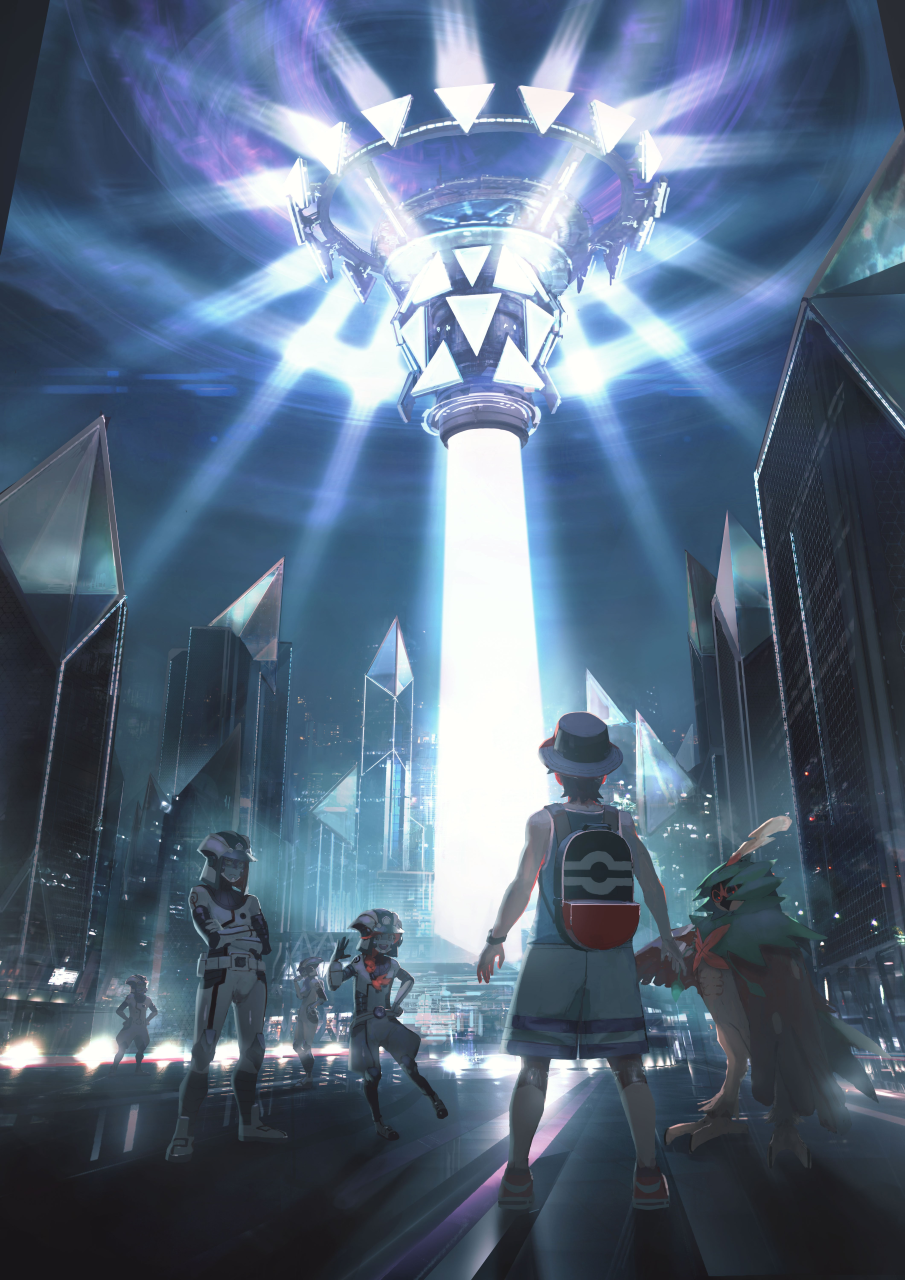
By the end of the games’ storyline, the members of the Ultra Recon Squad have come to believe that Necrozma’s lost light – the light restored when it achieves its Ultra Burst form – is the ultimate source of both Z-power and the mysterious “auras” that suffuse Alola’s totem Pokémon. The role of the crystals, then, is to “focus” the “light” – the life-giving sunlight that Necrozma shone onto Alola in ancient times, which may be not just literal light but some kind of life force that invigorates Pokémon and humans alike. Just as prisms can split light into many colours, Z-crystals can split the divine light into “colours” appropriate for the different Pokémon that use them, and just as lenses can focus light into powerful beams, the crystals can focus it into devastating Z-moves. The crystals themselves, I am inclined to suspect, may be literal fragments of Necrozma’s prismatic body, broken by whatever the ancestors of Ultra Megalopolis did to injure it all those years ago (since we are told that Necrozma literally lost a part of its body). Lillie makes a similar suggestion in a conversation back in Professor Kukui’s lab after all the dust has settled, though she thinks it’s the Sparkling Stones that are bestowed upon Kahunas and other special trainers by the Tapu. It could well be both. The Ultranecrozium-Z might, then, be a particularly large and important fragment, which, in combination with the light of Lunala or Solgaleo, is sufficient to temporarily restore Necrozma’s true form.
One little spanner in the works is that the Ultra Smoon website describes the Ultra Burst form as “a new form that even Necrozma had never taken until now.” Now, this would not be altogether inconsistent with the usual style of pre-release hype material that talks about, for instance, new moves or abilities – by “never until now” it is entirely plausible to me that they simply meant “never in the games we’ve previously played,” and not “never in any of the backstory.” Having said that, it’s not exactly watertight, and this has been the subject of an interesting bit of speculation by our very own Esserise, one of my Patreon supporters, suggesting that Necrozma once had an even greater form – perhaps entirely crystalline – that we never see, and that the members of the Ultra Recon Squad don’t know about (after all, they attribute Necrozma’s injuries to their “ancestors,” so they may have only a vague idea of what it was like in ancient times). I think I ultimately prefer the more straightforward reading that the Blinding One is exactly the same as the Ultra Necrozma we know, but that post is still worth a look, especially for some discussion of a published interview with game director Kazumasa Iwao, which reflects what seems to be an early draft of the plot of Ultra Smoon. I’m going to talk instead about the anime’s take.
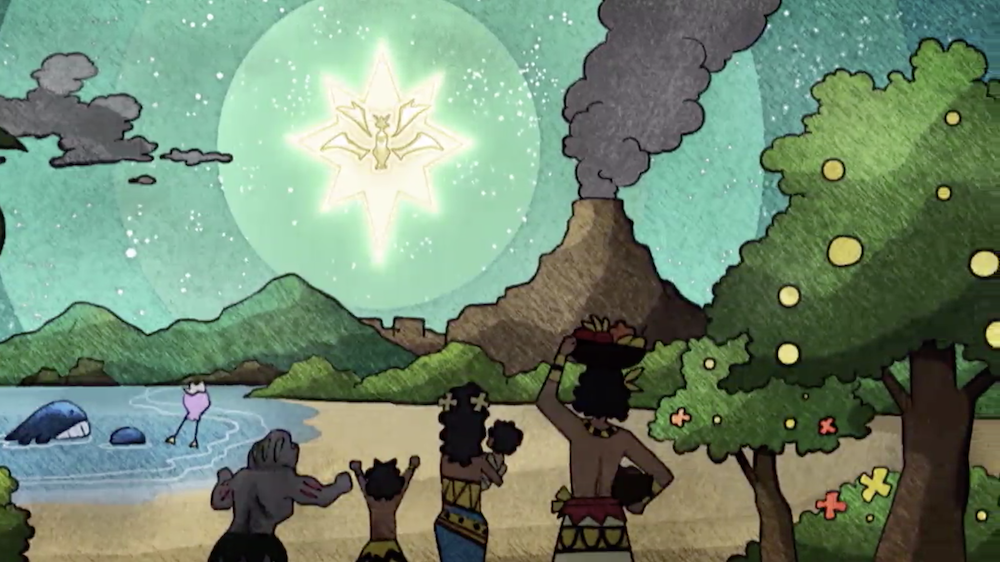
The Pokémon anime doesn’t feature the Ultra Recon Squad, and a lot of their plot relevance and exposition is instead transferred to a Poipole colony (the home of Ash’s Poipole) led by a telepathic Naganadel. The Ultra Megalopolitans’ name for Necrozma – “the Blinding One” – is instead a name out of Alolan myth, referencing a divine creature that brought light to the region in ancient times. Depictions of the Blinding One from ancient Alolan art are clearly images of our Ultra Necrozma. Ash’s Poipole indicates an affection for the Blinding One, and uses its developing artistic talents to paint its own images of the creature. When Necrozma actually appears, entering Alola in pursuit of Nebby the Solgaleo and a wild Lunala, it takes a while for the protagonists to make the connection between this sinister dark entity and the Blinding One of Alolan legend, but they get there eventually, thanks to Naganadel. As in the games, Necrozma was once the source of light for an entire world – Poipole’s world – which has become darkened in the wake of Necrozma’s injury, though in this version of the story it was damaged when it deflected a meteor to protect its world, not by the actions of humans. Ash’s Poipole was sent to Alola to find a new source of light, something Alola seems to have plenty of. When the kids pursue Necrozma to the darkened world in order to save Nebby, Gladion is all in favour of just defeating it and getting the hell out of there, leaving the Poipole to their own devices. Ash, softie that he is, instead comes up with a plan to try to heal Necrozma by using everyone’s Z-moves to share their own light with it. This only works after the Aether Foundation and the Kahunas, back in Alola, coordinate a massive effort to have all Alola’s people send their spiritual power to Necrozma through the Ultra Wormhole, capped off by Ash and Gladion teaming up with Nebby and Lunala for a final pair of ridiculously overpowered Z-moves. The end result is the restoration of Necrozma to its Ultra form, permanently (or at least that’s how the episode seems to frame it), allowing it to bring light to Poipole’s world once again.
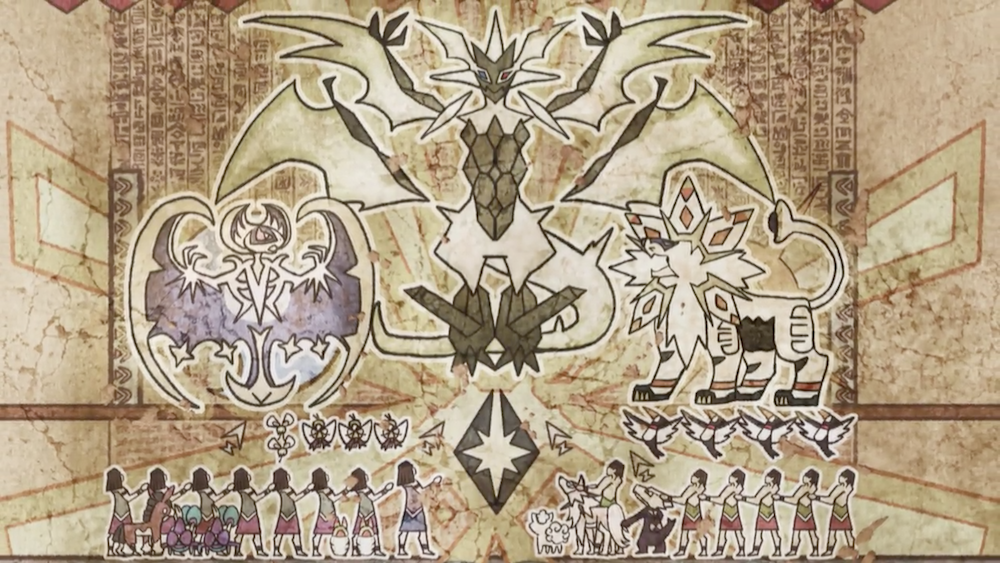
The anime sets up the resolution of Necrozma’s story as a lesson about the importance of selflessness, kindness and sharing. By reaching out to Necrozma, trying to understand it and help it in its suffering, and sharing their power with it instead of using that power to try to destroy it, Ash and his friends create a better world for everyone. I mean… don’t get me wrong, it’s a bit saccharine, but it’s definitely on-brand. An ancient Alolan text translated by Professor Burnet during the course of the relevant episodes provides a sort of rationale for Ash’s approach. According to her understanding of the mythology, the Blinding One’s relationship with the living things of ancient Alola was reciprocal; it gave them the light that enabled them to grow, and that growth in turn produced its own “light” that reinvigorated the Blinding One after it was exhausted by the effort of creation. Again I think a prism analogy, although perhaps not strictly intended, provides an interesting reading here. Prisms are fun because they can split white light into colourful rainbows. Just as notably, though, if you can catch a rainbow with a prism just right, you can focus it back into a single ray of white light. What prisms don’t do is create their own light. Even Ultra Necrozma doesn’t create light out of nothing. It needs a source, be that the life force of an entire world, or the radiance of a cosmic legendary Pokémon. All the disparate and vaguely-defined ambient energies of the world can be pulled together through Necrozma’s prism into the divine light of creation, and that same light can be refracted back into a rainbow that illuminates all living things (the colours of the “rainbow” perhaps representing the different types, each empowered by a particular Z-crystal). This reading also provides new context to the idea that the ancestors of Ultra Megalopolis damaged Necrozma as a result of their “greed” – maybe it was ultimately selfishness, or a refusal to go on sharing the light, that darkened their world. If it sounds like this is getting too far-fetched to be compatible with what we see in the games, I have one last piece of information I want to talk about.
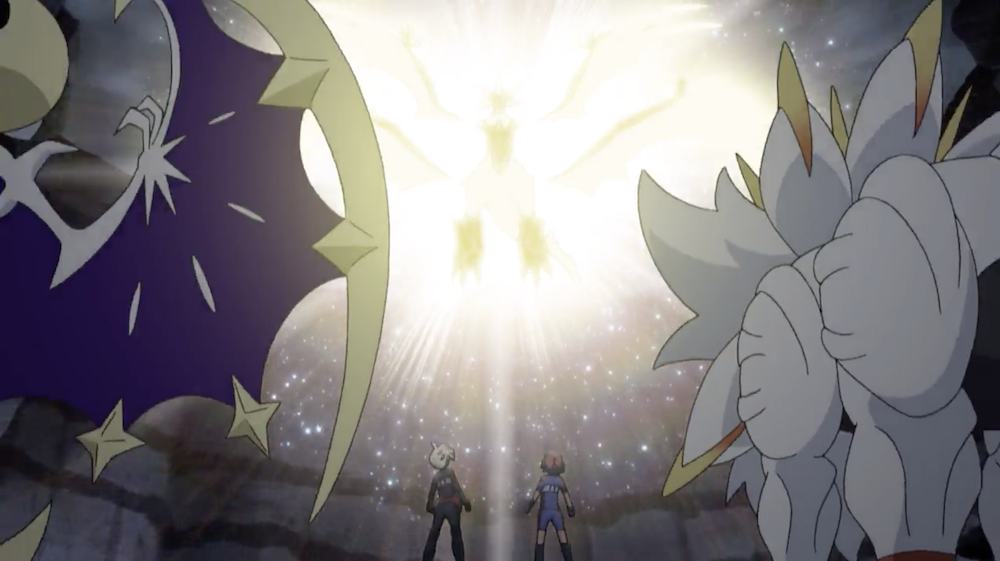
As we already know, Necrozma has visited Alola before, in ancient times. Its previous incursion is described in a secret book hidden in the Malie City Library, which the player can uncover in the postgame of Ultra Smoon with the help of Acerola. According to Acerola, this book was forbidden by an ancient king of Alola, her ancestor, who feared that widespread knowledge of the events it describes would create panic. After reading it, she agrees, and swears the player to secrecy. The text describes how “the pillager of light [identified by Acerola as Necrozma] descended from the sky and shrouded the world in darkness.” It then “took from us” either Lunala or Solgaleo, as appropriate to the version of the game you’re playing, “using the beast as its own Dawn Wings [or Dusk Mane],” which implies that this took place after Solgaleo and Lunala arrived in Alola and became objects of veneration for the Alolan royalty. Fortunately for all concerned, the four Tapu, working together with a young trainer, were able to free the legendary Pokémon and “[banish] the darkness” by “[using] the stones to summon the light once more.” Independent testimony from Phyco and Dulse places the event at Tapu Village, on Ula’ula Island. “The stones” are presumably Sparkling Stones and/or Z-crystals. At first glance, this sounds like an account of a battle in which Necrozma was defeated; that’s how Phyco and Dulse understand it, and Acerola seems to take it that way as well. The wording is… pretty vague, though. “The darkness was banished” and “the beast that devours the sun was freed” but no one says that the “pillager of light” was defeated. And what does “summon the light” actually mean? Yeah, maybe it means Necrozma was defeated by using Z-moves, but it’s also a pretty good description of exactly what happens in the anime. The heroes “banish the darkness,” not by defeating Necrozma, but by healing it, returning to it some measure of its lost divinity, if only for a time, through the use of the same power that it once gifted to them. We too, once Necrozma is on our side, get to “use the stones to summon the light” and restore the Blinding One – banishing the darkness, along with just about anything else that gets in our way.
Necrozma tends to get interpreted a lot as a very malevolent Pokémon, associated with destruction, darkness and chaos, and I’m coming to think that this is a bit of a one-sided view. It’s a prism, defined less by its own power and more by the light that shines through and around it. Deprived of light, it too becomes dark, but lit up by the light of the sun, it can bring life to entire worlds. So… that’s the last of the big ones! Magearna, Marshadow, Zeraora and Melmetal don ‘t have quite the same tangled mass of game and anime lore to tie knots in, so hopefully those entries will turn out to be a bit more manageable. At least, in principle. I guess we’ll see how that goes.
Honour and glory above all to the Patrons who move my mysterious ways, and chief among them to Verb, Lord President of my Dark Council, whose will shall not be questioned.

It should be noted that Light That Burns The Sky also goes on for about a minute, despite still only taking the one turn.
LikeLike
I thought Necrozma wasn’t considered an ultra beast because it’s been outside of Ultra Space for so long that it’s lost its “aura” from ultra space, and adapted to the native environment to the point it’s become more like a terrestrial Pokémon. The same reason Cosmog and its matured forms aren’t ultra beasts but kindof are. Otherwise the numerous legendaries you can get through ultra space may as well be considered ultra beasts as well.
LikeLike
What’s the source for that reasoning?
LikeLike
I think they might be basing it on the fact that Wicke says the Beast Boost (and the red aura when fighting wild Ultra Beasts) are qualities picked up when traveling through Ultra Wormholes rather than innate to the Ultra Beasts.
I’m not necessarily sure that can be said to mean “it used to be an Ultra Beast and now definitively isn’t one,” though. If it was ever an Ultra Beast at all, I would think it was more like “it is an Ultra Beast, but it no longer reads as one/can no longer be detected as one for lack of a red aura” (which would also be why the Beast Ball isn’t necessary or effective… I’m REALLY curious to know if the game internally decides its effectiveness based on a particular list of species or if it’s decided by the battle itself having that red aura defined). And of course it could also never have been an Ultra Beast to begin with, but that doesn’t seem to make much sense, does it?
Lorewise, it’s somewhat unclear whether it’s the red aura or some innate quality of the species themselves that makes Ultra Beasts harder for Poké Balls to recognize as Pokémon. Wicke cites the fact that they’re lifeforms from another world as what makes Beast Balls necessary, but she actually doesn’t outright say why that is – it could be because their biology in itself is too alien (like you wrote in this article), but she also says that what makes UBs “special” IS the Beast Boost and the red aura, which are merely consequences of the *act* of coming from another world and nothing intrinsic to those species.
Unfortunately, USUM only confuse this further. When we face UBs in their home worlds, Beast Balls are still just as effective as in SM, even though those UBs never passed through a wormhole to reach us (actually, *we* passed through a wormhole to reach *them*). But the UBs we face in USUM still DO have Beast Boost and red auras – what are we even supposed to take from that? The bit this contradicts isn’t even what makes Beast Balls work but how UBs end up with the Beast Boost in the first place, so it’s hard to interpret its consequences on the lore and it was probably just an oversight altogether…
One thing I’d really like to know is how the game decides the Beast Ball’s effectiveness. From a mechanical standpoint, either of these possibilities has exactly the same effect in normal gameplay and there’s no way to distinguish them on the surface, so it’s not exactly sound or conclusive evidence (either one could just have been whatever happened to be easier for implementation), but on a meta level, I think it’s at least potentially an interesting look into the developers’ heads.
What I’m wondering is whether it’s a matter of checking a particular list of species (possible points to the “unique biology” side, which, if true, would imply that Necrozma does not have the biological qualities that constitute UBs, and nor do the Cosmog line) or checking for either the Ability Beast Boost or the fact that the opponent is defined with a red stat-boosting aura (possible points to the “passing through an Ultra Wormhole” side, which, if true, would imply that Necrozma and the Cosmog line would have been considered Ultra Beasts if they’d been discovered when that still applied).
Then again, we’re also left with the question of “why doesn’t Ultra Warp Ride give Nebby the Beast Boost? why wasn’t Necrozma’s Beast Boost restored any of the times it passed through an Ultra Wormhole in USUM?” It’s confusing and speculative all around, so I don’t think we’ll ever have a clear answer one way or another. I remember being confident that the Cosmog line and Necrozma were UBs when Sun and Moon first came out, but thinking about it more since then has left me far less certain.
LikeLiked by 1 person